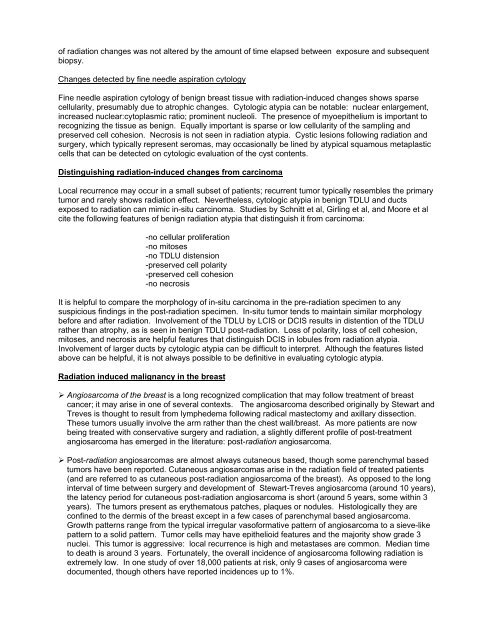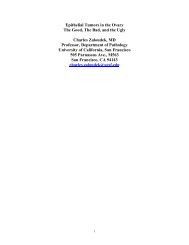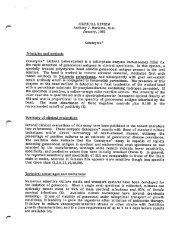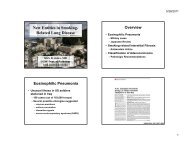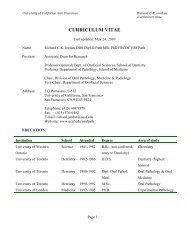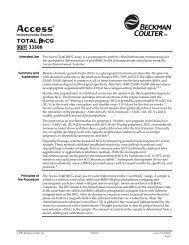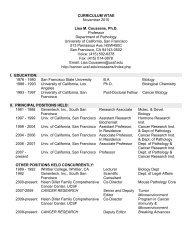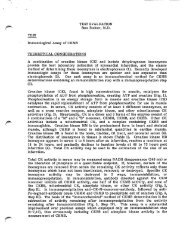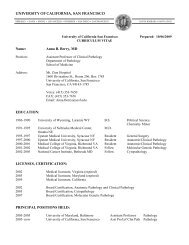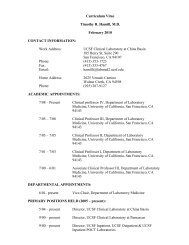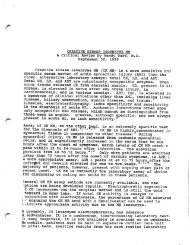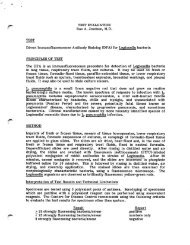Treatment Induced Changes in the Breast: Diagnosis and Staging of ...
Treatment Induced Changes in the Breast: Diagnosis and Staging of ...
Treatment Induced Changes in the Breast: Diagnosis and Staging of ...
You also want an ePaper? Increase the reach of your titles
YUMPU automatically turns print PDFs into web optimized ePapers that Google loves.
<strong>of</strong> radiation changes was not altered by <strong>the</strong> amount <strong>of</strong> time elapsed between exposure <strong>and</strong> subsequent<br />
biopsy.<br />
<strong>Changes</strong> detected by f<strong>in</strong>e needle aspiration cytology<br />
F<strong>in</strong>e needle aspiration cytology <strong>of</strong> benign breast tissue with radiation-<strong>in</strong>duced changes shows sparse<br />
cellularity, presumably due to atrophic changes. Cytologic atypia can be notable: nuclear enlargement,<br />
<strong>in</strong>creased nuclear:cytoplasmic ratio; prom<strong>in</strong>ent nucleoli. The presence <strong>of</strong> myoepi<strong>the</strong>lium is important to<br />
recogniz<strong>in</strong>g <strong>the</strong> tissue as benign. Equally important is sparse or low cellularity <strong>of</strong> <strong>the</strong> sampl<strong>in</strong>g <strong>and</strong><br />
preserved cell cohesion. Necrosis is not seen <strong>in</strong> radiation atypia. Cystic lesions follow<strong>in</strong>g radiation <strong>and</strong><br />
surgery, which typically represent seromas, may occasionally be l<strong>in</strong>ed by atypical squamous metaplastic<br />
cells that can be detected on cytologic evaluation <strong>of</strong> <strong>the</strong> cyst contents.<br />
Dist<strong>in</strong>guish<strong>in</strong>g radiation-<strong>in</strong>duced changes from carc<strong>in</strong>oma<br />
Local recurrence may occur <strong>in</strong> a small subset <strong>of</strong> patients; recurrent tumor typically resembles <strong>the</strong> primary<br />
tumor <strong>and</strong> rarely shows radiation effect. Never<strong>the</strong>less, cytologic atypia <strong>in</strong> benign TDLU <strong>and</strong> ducts<br />
exposed to radiation can mimic <strong>in</strong>-situ carc<strong>in</strong>oma. Studies by Schnitt et al, Girl<strong>in</strong>g et al, <strong>and</strong> Moore et al<br />
cite <strong>the</strong> follow<strong>in</strong>g features <strong>of</strong> benign radiation atypia that dist<strong>in</strong>guish it from carc<strong>in</strong>oma:<br />
-no cellular proliferation<br />
-no mitoses<br />
-no TDLU distension<br />
-preserved cell polarity<br />
-preserved cell cohesion<br />
-no necrosis<br />
It is helpful to compare <strong>the</strong> morphology <strong>of</strong> <strong>in</strong>-situ carc<strong>in</strong>oma <strong>in</strong> <strong>the</strong> pre-radiation specimen to any<br />
suspicious f<strong>in</strong>d<strong>in</strong>gs <strong>in</strong> <strong>the</strong> post-radiation specimen. In-situ tumor tends to ma<strong>in</strong>ta<strong>in</strong> similar morphology<br />
before <strong>and</strong> after radiation. Involvement <strong>of</strong> <strong>the</strong> TDLU by LCIS or DCIS results <strong>in</strong> distention <strong>of</strong> <strong>the</strong> TDLU<br />
ra<strong>the</strong>r than atrophy, as is seen <strong>in</strong> benign TDLU post-radiation. Loss <strong>of</strong> polarity, loss <strong>of</strong> cell cohesion,<br />
mitoses, <strong>and</strong> necrosis are helpful features that dist<strong>in</strong>guish DCIS <strong>in</strong> lobules from radiation atypia.<br />
Involvement <strong>of</strong> larger ducts by cytologic atypia can be difficult to <strong>in</strong>terpret. Although <strong>the</strong> features listed<br />
above can be helpful, it is not always possible to be def<strong>in</strong>itive <strong>in</strong> evaluat<strong>in</strong>g cytologic atypia.<br />
Radiation <strong>in</strong>duced malignancy <strong>in</strong> <strong>the</strong> breast<br />
Angiosarcoma <strong>of</strong> <strong>the</strong> breast is a long recognized complication that may follow treatment <strong>of</strong> breast<br />
cancer; it may arise <strong>in</strong> one <strong>of</strong> several contexts. The angiosarcoma described orig<strong>in</strong>ally by Stewart <strong>and</strong><br />
Treves is thought to result from lymphedema follow<strong>in</strong>g radical mastectomy <strong>and</strong> axillary dissection.<br />
These tumors usually <strong>in</strong>volve <strong>the</strong> arm ra<strong>the</strong>r than <strong>the</strong> chest wall/breast. As more patients are now<br />
be<strong>in</strong>g treated with conservative surgery <strong>and</strong> radiation, a slightly different pr<strong>of</strong>ile <strong>of</strong> post-treatment<br />
angiosarcoma has emerged <strong>in</strong> <strong>the</strong> literature: post-radiation angiosarcoma.<br />
Post-radiation angiosarcomas are almost always cutaneous based, though some parenchymal based<br />
tumors have been reported. Cutaneous angiosarcomas arise <strong>in</strong> <strong>the</strong> radiation field <strong>of</strong> treated patients<br />
(<strong>and</strong> are referred to as cutaneous post-radiation angiosarcoma <strong>of</strong> <strong>the</strong> breast). As opposed to <strong>the</strong> long<br />
<strong>in</strong>terval <strong>of</strong> time between surgery <strong>and</strong> development <strong>of</strong> Stewart-Treves angiosarcoma (around 10 years),<br />
<strong>the</strong> latency period for cutaneous post-radiation angiosarcoma is short (around 5 years, some with<strong>in</strong> 3<br />
years). The tumors present as ery<strong>the</strong>matous patches, plaques or nodules. Histologically <strong>the</strong>y are<br />
conf<strong>in</strong>ed to <strong>the</strong> dermis <strong>of</strong> <strong>the</strong> breast except <strong>in</strong> a few cases <strong>of</strong> parenchymal based angiosarcoma.<br />
Growth patterns range from <strong>the</strong> typical irregular vas<strong>of</strong>ormative pattern <strong>of</strong> angiosarcoma to a sieve-like<br />
pattern to a solid pattern. Tumor cells may have epi<strong>the</strong>lioid features <strong>and</strong> <strong>the</strong> majority show grade 3<br />
nuclei. This tumor is aggressive: local recurrence is high <strong>and</strong> metastases are common. Median time<br />
to death is around 3 years. Fortunately, <strong>the</strong> overall <strong>in</strong>cidence <strong>of</strong> angiosarcoma follow<strong>in</strong>g radiation is<br />
extremely low. In one study <strong>of</strong> over 18,000 patients at risk, only 9 cases <strong>of</strong> angiosarcoma were<br />
documented, though o<strong>the</strong>rs have reported <strong>in</strong>cidences up to 1%.


